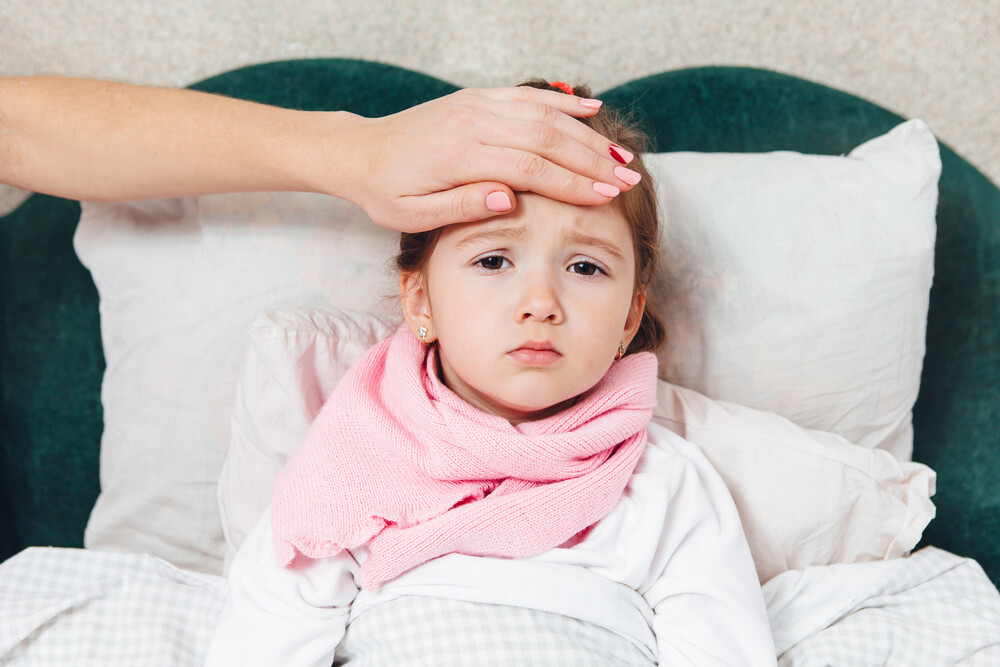At what point do babies and children have a fever? What can cause fever in children and when do they need a doctor? You can find all the information here.
Fever in itself is not a disease. The increase in body temperature is a protective reaction of the body to defend itself against pathogens and to mobilise its defences. Even if you are worried about your feverish child, in most cases the fever is harmless and should not immediately be kept in check by antipyretic measures such as suppositories or other medication.
Body temperature in children
Healthy children have a body temperature between 36.5 and 37.5 degrees Celsius. A temperature between 37.6 and 38.5 degrees is called elevated temperature. From 38.5 degrees Celsius on, fever begins, and at over 39 degrees Celsius the child has a high fever.
Childhood fever: Causes
Children get a fever faster than adults, but normally recover faster from the high body temperature even without antipyretic drugs. In many cases the causes of the fever are harmless. These are the most common diseases that cause fever in children:
- Infections of the respiratory tract: cough, sore throat, rhinitis
- Tonsillitis: sore throat, difficulty swallowing, sometimes coatings on the tonsils
- Bronchitis: coughing, partial shortness of breath
- Middle ear infection: earache
- Gastrointestinal infection: vomiting and diarrhoea
- Pneumonia: cough, shortness of breath, abdominal pain
- Urinary tract infection: frequent, painful urination, bed-wetting
- Meningitis: headache, stiff neck, light shyness
- Childhood diseases such as chickenpox, three-day fever, rubella, scarlet fever, measles and mumps
- Appendicitis: stomach ache, nausea, vomiting
- Vaccination reaction: only slight fever, usually without further signs of illness
Taking a temperature
If you feel that your child has a fever and may have other symptoms, check the body temperature. If your suspicion is confirmed, you should now give your child sufficient bed rest, be careful that there is no lack of fluids and check the fever at regular intervals. But what is the best way to measure fever in children?
- The determination of the body core temperature works most reliably rectally. To do this, grease the tip of the clinical thermometer with a little Vaseline and carefully insert it about one to two centimetres into your child’s anus.
- If the rectal measurement is not successful, an ear thermometer is also suitable, which measures the temperature at the eardrum with infrared sensors. However, a little practice is required to obtain correct measurement results. However, measuring in the ear is not suitable for infants, as their tiny auditory canals cannot provide reliable results.
- Measurements with the clinical thermometer in the mouth or under the armpit are not recommended for children because they are particularly susceptible to interference and can therefore falsify the measurement result.
The dreaded febrile convulsion
Febrile convulsions are rare and are less dangerous than they look, but you should be prepared if your child gets a febrile convulsion. The spasm is a reaction of the nervous system and manifests itself as twisted eyes, blue lips, stiff, twitching limbs and possibly loss of consciousness.
Febrile convulsions usually last three to four minutes and usually pass by themselves without any health consequences. Nevertheless, if you have febrile convulsions, you should make an emergency call to rule out possible complications and, if necessary, have your child treated with medication.
When to see a pediatrician?
Very young babies can have infections without developing a fever. This is because the body must first develop the ability to fight viruses and bacteria with fever. Therefore, even if your baby does not have a fever, you should take your baby to a pediatrician if the following symptoms occur:
- Refusal to eat
- Unusual colouring of the skin
- Skin rash
- Diarrhoea and/or vomiting
- Changes in behaviour
- Other diseases
For older babies and children, a visit to the pediatrician is advisable if
- the fever lasts longer than a day.
- the fever does not fall despite antipyretic agents (calf compresses, suppositories)
- the fever occurs intermittently.
- you observe further signs of illness (vomiting, diarrhoea, skin rash, abdominal pain).
- your child has had a fever convulsion.
- your child suffers from chronic diseases, such as immune deficiency or heart disease
In most cases, the paediatrician will find a harmless cause and, if necessary, prescribe medication such as fever suppositories, paracetamol or ibuprofen to lower the fever.

